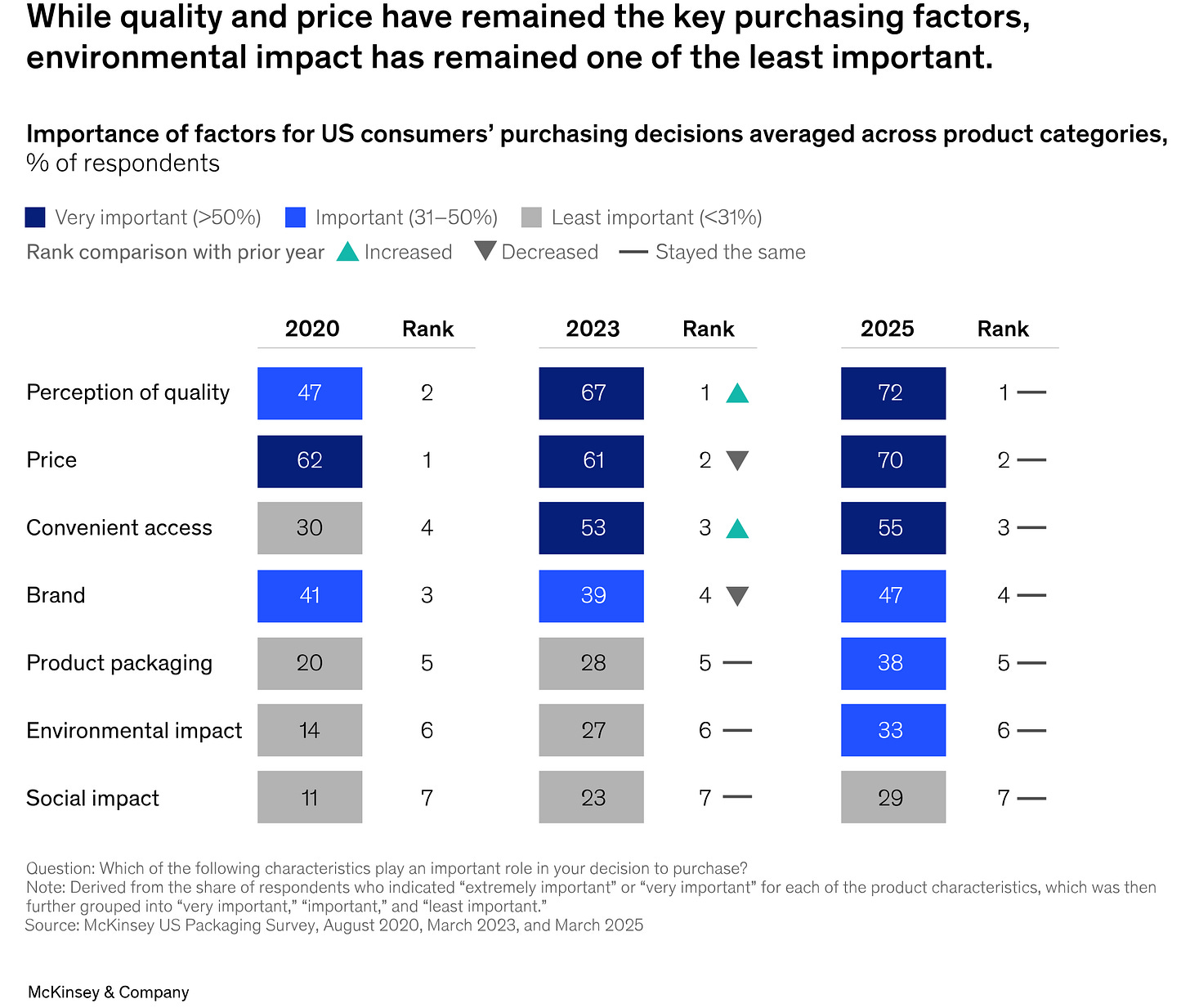Do Customers Really Care About Sustainability?
Last month, in my series about the green premium, I emphasized the importance of customer driven value creation. My central thesis was simple: if a company doesn’t understand its customers, it can’t deliver the value they actually want. Too often in climate tech, companies fall into the trap of just prioritizing sustainability impact without critically thinking enough about who their end customer really is.
Recently, I came across a Mckinsey case study1 that touched this tension, through the lens of sustainable packaging. Mckinsey surveyed thousands of individuals across 11 countries and 4 continents, asking about their attitudes towards sustainable packaging.
Some of the findings were quite intriguing and I think apply far beyond sustainable packaging. In this post, I explore how this research applies more broadly to the climate tech industry and how, as an aspiring VC, I think about investing in this context.
Understanding Value
One of my main takeaways from the case study is that consumers consistently rank price, quality, and convenience as more important than a product’s environmental impact. In fact, across all surveyed markets, these three factors were consistently in the top three or four priorities, as shown below2.
So, now the question becomes:
Does the “average person” care about if a product is sustainable?
In my view, most people do care about climate at a high level. But when it comes to their purchasing decisions, they focus, rightfully so, on how a product affects their own day to day lives. Price, quality, and access win out, as shown by this study. Only when those are equal across two products does environmental impact reliably become a deciding factor.
Perhaps just as important, is the idea of selling to consumers who don’t care about climate. I often get asked, “How can we convince those people to care?” But I think that question misses the point. Rather than forcing individuals to care about factors they are less interested in, I think it is more important that entrepreneurs and investors focus on meeting people where they are.
In diverse markets, where some consumers prioritize climate and others don’t, companies that build cost-effective, high-quality, accessible solutions that also drive climate impact through technology will be able to thrive.
What does this mean for VCs and startups in climate tech?
Both VCs and startups should prioritize products that aim to lead in price, quality, and access. This could come in multiple forms:
For startups
Leveraging economies of scale to improve price competitiveness
Investing in R&D to creatively build high quality products
Proactively finding and reaching their ideal customers
For VCs
Factoring startup price competitiveness into investment decisions
Supporting portfolio companies in commercialization without compromising on quality
Leveraging networks to help startups reach their target customers
Brand Matters
Another takeaway from this case study: consumers believe companies, not individuals, are responsible for sustainability3. Many don’t want to shoulder the burden of choosing the “right” product, especially if that comes with a green premium or extra work.
If climate tech companies push that burden onto consumers, they risk losing them to easier, incumbent solutions.
So what should climate tech startups do?
First, build a strong brand around climate-positive impact while still delivering on price, quality, and access. That doesn’t mean every customer has to care about this mission. But for those who do, your brand becomes a deciding factor. For everyone else, products will win based on price, quality, and convenience.
Second, make sustainable choices easy. This study showed that customers don’t want extra steps or more responsibilities to deal with. While easier said than done, companies that can embed climate impact into a seamless, competitive customer experience will unlock real growth.
As an aspiring VC, I want to invest in companies that lead with thoughtful customer insight and build climate solutions that work for everyone, not just climate-first buyers. I believe these businesses, that appeal to a diverse marketplace, will see sustainable (in both senses of the word) growth in the future.
At the end of the day, it is up to the climate tech ecosystem to create the incentive structure that promotes thoughtful, scalable climate innovation. Let’s step up and start selling value in order to make that possible.
I’d love to hear your thoughts! Leave a comment or send me an email about ways that you think climate tech can deliver for a diverse set of customers.
Each week on The Climate Tech VC Journey, I’ll share lessons I’m learning on my journey to build a career in climate tech VC, insights from conversations with people in the space, and reflections on compelling industry trends. Feel free to reach out with questions, feedback, or just to chat—email me at rrsaxen0@chicagobooth.edu!
https://www.mckinsey.com/industries/packaging-and-paper/our-insights/do-us-consumers-care-about-sustainable-packaging-in-2025?stcr=85879488484D4F078AC6933CE2932A92&cid=other-eml-alt-mip-mck&hlkid=2a875e2c28ef494286b692d92313a484&hctky=16411086&hdpid=751c1115-c102-4b72-bba0-8d76d89706ed
https://www.mckinsey.com/~/media/mckinsey/industries/paper%20and%20forest%20products/our%20insights/do%20us%20consumers%20care%20about%20sustainable%20packaging%20in%202025/svgz-mck258300%20sustainability%20in%20packaging%20exhibits-updated060225_ex1.svgz?cq=50&cpy=Center
https://www.mckinsey.com/~/media/mckinsey/industries/paper%20and%20forest%20products/our%20insights/do%20us%20consumers%20care%20about%20sustainable%20packaging%20in%202025/svgz-mck258300%20sustainability%20in%20packaging%20exhibits%20v2-expanded_ex5.svgz?cq=50&cpy=Center





